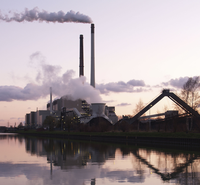
Photo from wikipedia
Temporary emission control measures in Beijing and surrounding regions have become a prevailing practice to ensure good air quality for major events (e.g. the Asia-Pacific Economic Cooperation (APEC) Summit on… Click to show full abstract
Temporary emission control measures in Beijing and surrounding regions have become a prevailing practice to ensure good air quality for major events (e.g. the Asia-Pacific Economic Cooperation (APEC) Summit on 5–11 November 2014) and to mitigate the severity of coming pollution episodes. Since PM2.5 affects meteorology via aerosol–meteorology interactions, a question arises how these interactions may impact the response of PM2.5 to emission reductions and thus the effectiveness of emission control measures. Here we use the coupled meteorology-chemistry model WRF-Chem to investigate this issue with focus on aerosol–radiation interactions (ARI) for the APEC week and three more polluted episodes over North China. We find a quadratic relationship between PM2.5 concentration changes due to emission reductions and PM2.5 levels, instead of an approximately linear response in the absence of ARI. The ARI effects could only change the effectiveness of emission control by 6.7% during APEC in Beijing, but reach 21.9% under more polluted conditions. Our results reveal that ARI can strongly affect the attribution of PM2.5 variability to emission changes and meteorology, and is thus important for assessing the effectiveness of emission control measures.
Journal Title: Environmental Research Letters
Year Published: 2019
Link to full text (if available)
Share on Social Media: Sign Up to like & get
recommendations!